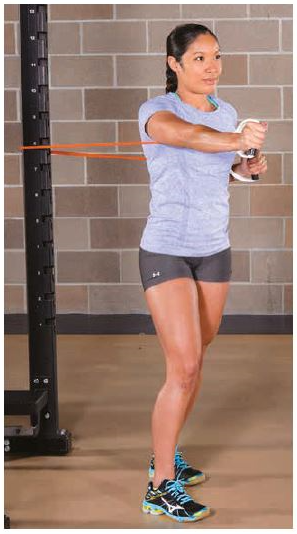Resistance Band Training
by Strength Training
Kinetic Select
October 2021
This excerpt from Strength Training, Second Edition provides insight into how resistance bands and cords can be used for a variety of training methods.
The following is an exclusive excerpt from the book Strength Training, Second Edition, published by Human Kinetics. All text and images provided by Human Kinetics.
The use of resistance bands and cords as a form of exercise is becoming increasingly popular. These are not regular rubber bands from your local office supply store. Rather, exercise bands and cords come in a variety of bright colors and in either flat sheets (resistance bands) that are approximately four inches (10.2 cm) wide by 6 feet (1.8 m) long or longer cables (resistance cords). Each color corresponds to a particular degree of tension. As with normal rubber bands or bungee cords, the tension in resistance bands and cords increases as they are stretched; this provides the resistance necessary for strength training. You can combine different levels of resistance to create a customized workout.
Resistance bands and cords are an effective complement or alternative to any strength and power training workout. For example, a boxer can wrap a resistance band around her back or a stable machine, grip the ends of the band in each of her hands, and throw a variety of punches (figure 6.12). This is a great way to build punching power and strength in a manner that isn’t possible with other equipment. Resistance bands are also very popular among advanced lifters for targeting the lock-out of lifts such as the squat or bench press. Attaching resistance bands to the ends of the bar and anchoring them to the floor or the bottom of the rack adds resistance at the top of the lift, which allows the lifter to have overload on certain lifts and have a stronger lock-out.

Figure 6.12 Performing punches with an elastic band increases the tension throughout the movement.
Resistance bands and cords also have the characteristic recoil or “pulling back” effect found in normal rubber bands. This produces the added benefit of exercising agonist muscles while stretching out antagonist muscles (see chapter 1 for a discussion of agonist and antagonist muscles). For example, when performing a biceps curl, the agonist muscles are your biceps and any other muscle aiding in the movement, whereas the triceps are the antagonist (or opposing) muscle. This tendency for the band or cord to return to its original shape leads to improvements in overall strength and joint stability.
It is not uncommon to see resistance bands and cords being used in a rehabilitation setting. The light resistance they provide makes them perfect for beginning exercisers as well as people who have limited muscle strength or who are recovering from an injury. Sitting or standing on a smaller elastic band and performing a shoulder press can allow the user a light resistance to help build up strength and assist in shoulder recovery.
Most resistance bands and cords are relatively inexpensive. Like medicine balls, resistance bands and cords offer a convenient and inexpensive form of exercise. Connect one end to a stable stationary object and you are ready to perform a variety of exercises. Also, the compact size of the bands and cords makes them easy to travel with, so you can do a strength training workout almost anywhere. Because these cords and bands stretch, they make it possible to strengthen the corresponding muscle throughout the entire range of motion.
Regrettably, resistance bands and cords do not come without limitations. It can be difficult to find resistance bands or cords in some public gyms. Moreover, very few sporting goods stores carry these items for retail purposes. However, a simple Internet search for a fitness, training, or rehabilitation equipment store can help you get your hands on a set of resistance bands or cords. Another drawback of the bands and cords is that because the resistance gets greater the farther you stretch them, you get only minimal resistance at the beginning of the movement, resulting in minimal gains in strength and power at these early angles. As a result, users may experience uneven gains in muscle strength and power. Fortunately, though, resistance bands and cords are very safe, and using them requires no specific training. Resistance bands and cords can be great additions to your overall exercise plan. Nonetheless, they should not be used as your sole means of gaining strength and power; rather, they should be used to supplement your existing training.
The popularity of endurance sports continues to grow worldwide. Now, from the National Strength and Conditioning Association (NSCA) comes the definitive resource for developing the endurance training programs that maximize performance and minimize injuries. The book is available in bookstores everywhere, as well as online at the NSCA Store.
- Privacy Policy
- Your Privacy Choices
- Terms of Use
- Retraction and Correction Policy
- © 2025 National Strength and Conditioning Association